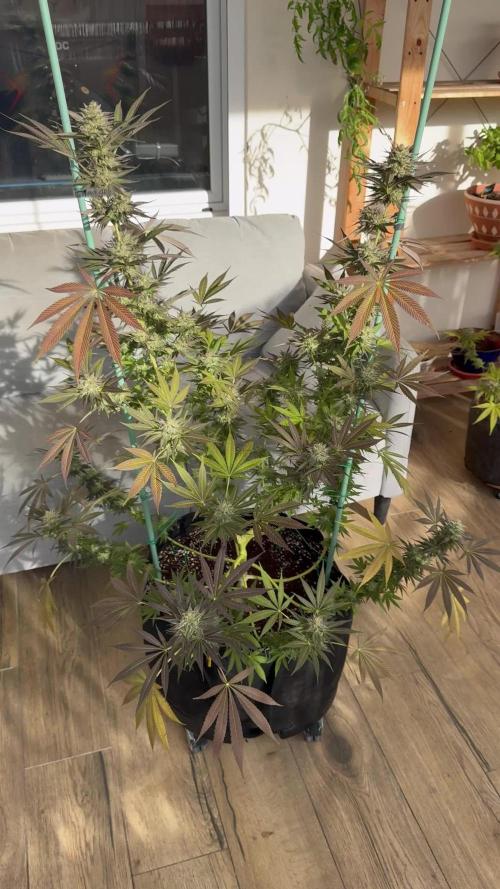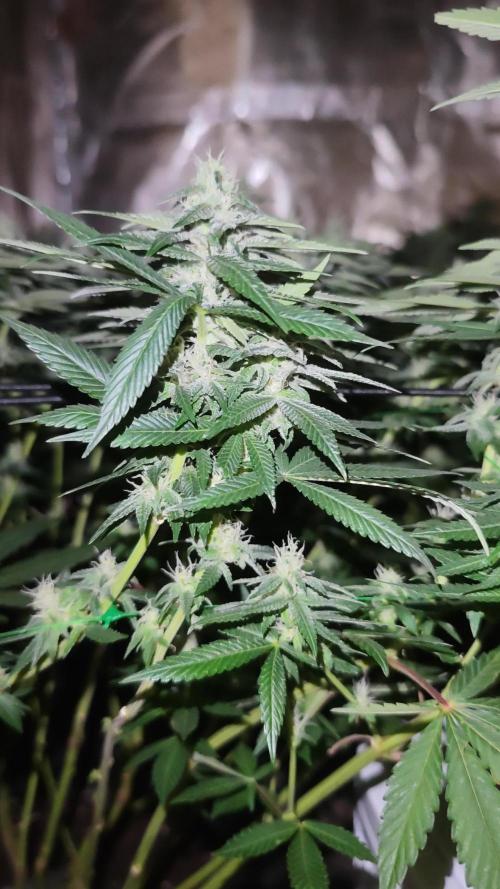The Grow Awards 2026 🏆 





























Likes
Comments
Share


@Fibro_Witch
Follow
Aubergine is doing well. She's bulking up a little more with flower. I gave her some homemade compost since she's looking hungry. One of the sets of buds has some purpling on it that I tried to show in the pictures. No tomato roof this week, my plans didn't work out so I have to make a trip to Lowe's. Next week hopefully before the cold and rain sets in.
Likes
8
Share


@Hippity
Follow
Refilled the Botaniums today, 7 days after the previous fill, as I saw they were completely empty. One of the plants is starting to show a tiny bit of weird coloring on some leaves and the texture of the leaves is also a bit strange. The other plant looks completely healthy.
Likes
12
Share


@AGP90
Follow
Been trying to correct a problem over last few days started with a flush and lowering nutrients. Hopefully will get better but not 100 % on what it is.
Likes
20
Share


@Chubbs
Follow
420Fastbuds
FBT2305 Week 8
What up grow fam. Weekly update on these redheads. They both are almost identical in size, structure, and smell. Really excited to see what will come of these two in the coming weeks. I'll keep up everything the same as the plants seem to be responding excellent to nutes every 3rd feeding. I might do a mild defoliation in the coming week to allow more light to lower flower sites. All in all Happy Growing.
Likes
72
Share


@DreamIT
Follow
🐩👤Sirius Black👤🐩 by 🌍🌱WeedSeedsExpress🌱🌍
👤 29.3 ...
👤 30.3 ...
👤 31.3 ...
👤 1.4 Begin to see a swelling of the flowers, it was time: D begins to feel a slightly sweet scent but we wait a little longer to feel the veterinarian characteristics of this beauty. Viparspectra always works to the maximum, I am enthusiastic about this lamp, I can't wait to mount the XS1000 too. in a week I will soak another seed, I hope to catch the colored one: p
👤 2.4
👤 3.4
👤 4.4
__________________________________________
👀Are you looking for a good lamp to start?👀
Viparspectra in my opinion has something more than the others, take a look at their site.
➡️ http://bit.ly/pro-seriesproductspro-series-p1500
⏩Use " GDVIP " for an extra discount💯
____________________________________________________________________________________
📜👀 A look at the details of what I'm growing 👀📜
🐩👤Sirius Black👤🐩 by 🌍🌱WeedSeedsExpress🌱🌍
📋 Details 📋
⚧ Gender
▪️ Feminised
➰ Genes
▪️ 70% Indica / 30% Sativa
🎄 Genetics
▪️ Sirius Black
🚜Harvest
▪️ 450 g / m²
🌷Flowering
▪️ 63 - 70 days
✨THC
▪️ 25.0%
✅CBD
▪️ 0.5%
🏡Room Type
▪️ Indoor
🌄Room Type
▪️ Outdoor
🕋Room Type
▪️ Greenhouse
🎂Release Year
▪️ 2020
____________________________________________________________________________________
👀📷 Follow the best photos on instagram 📷👀
https://www.instagram.com/dreamit420/
🔻Leave a comment with your opinions if you pass by here🔻
🤟🤗💚Thanks and Enjoy growth 💚🤗🤟
Likes
18
Share


@UnitedStrainsGermany
Follow
Es läuft alles nach Plan die Blätter sehen gesund aus kein Ungeziefer also alles guuut.
Likes
4
Share


@GODAXE
Follow
2024.09.12 D64
Its been two busy week,
as i trim the 1 pond mother, get aknowledge that my wife use my grow sniper two pruned is badly infested rose bush, since 2 week and never proper clean it whith alcool.😱😱😱😷
in result a massive PM & mithe contamination in my grow tent... 😱😭😷😭
all plant have been shoot with H2O2 at 0.5% and set ouside for 2 day, wich turn to be rainy as f***, until i clean and serilized everything, twice and run the hepa filter .😷😰
the plant look ok, lightly over wartered, but no more pest or PM sign as they return in the tent..
3 days later PM hardly bonce back, no choice to use more agressive treatment so they all have been shoot with saffer's defender 3 in 1.
after 3 shoot in 24h and another tent desinfection we should have get rid of it 🙏
8 day laters everything look fine👍, all damage leaf have been removed, i also prune some unrelevant lower and inner grow
Likes
2
Share


@Earthsower
Follow
At the end of week 11 the blue dream has done extremely well. She is fully recovered with pale lateral branches and the leaves are soft smooth with 7 fingers with no burnt tips. Her canopy is complete and her stem is stalk like. She has been defoliated the substrate has been loosened and sgrown 5cm this week standing at 73cm tall The blue dream is ready for bloom with no special attention required.
Likes
7
Share


@Messypies
Follow
This week started strong. Some small concerns due to small orange spots appearing on fan leaves which on researching indicates a calcium/magnesium deficiency. Will add a small amount of cal mag to their next feed
Likes
57
Share


@SmokieMcPot
Follow
***UPDATE***
ITS CHOPPIN DAY!! Late in day 87 I was going for macros. Made the decision while seeing MANY yellow trichomes that Wedding Glue from FastBuds is DONE! Attaching pics to the beginning of the weeks uploads. She sure turned out pretty asf didn't she? Lights out occurs in like 30min, and I'm going to work through the dark period stripping the large fans off. Utilizing my green Christmas lights hung up above lol. May turn light on low for a quick pic before chopping/hanging. Next update will be harvest!
2 Girls 1 Cup week 12? Hopefully the finish is this week... My my my how WG has fattened up the last 2 weeks. Trying to get some good macros since it's too hard to hold the scope to my phone and focus everything. Probably better for the existing trics too since they're not being touched.
Day 84- these trics are taking their sweet time to ripen. Was considering picking up some GHE Ripen to speed the process up.. especially because a local shop is closing and everything is 40% off. Let's keep it simple this run. I'll get some additives for the next grow to enhance GHE's perfected formulas of macro/micros in the Flora series. An update on the "sample" I clipped from WG the other day. It's not dried/cured proper. Actually been sitting in a brown bag with the outlet of the tent blowing on it lol. Can taste some vanilla in it through the chlorophyll and shit still in the flowers. VERY heady effect that hits me like a friggin wave. Creativity and energy uplifted for sure. Looking for the bodies in there too to help with pain, so we shall wait even longer for those ambers to show.
====================================================
==========================
==========================
Day 85- stepped up our hole a size or two.. lol. May bring home the step bit to drill again before a dark period at the end. The girls STINK! Getting VERY close to chopping day. Ooooh I can't wait (but I gotta). Headies lasting between 2-3hrs which is great.
====================================================
==========================
==========================
Day 86- yellowing more as the days pass. no more ambers showing yet.. wasn't able to score anything good from the local shop today since it was almost empty already. Picked up a grove bag to give it a whirl with curing. May put some in glass to compare side by side with the bags. Figured I'd give their roots an ice bath since I've done other bro science. Shit, GK still hasn't popped a nanner after all I've put her through 🤣.
*edit* added some late day WG only pics to show her fall colors coming in. Moving in fast now. Gotta get back up in WG's guts now and scope the progress daily.
====================================================
==========================
==========================
Day 87- the smell in the tent has become so powerful, I next day air'd a new charcoal filter 🤣. This one was reaching the end of its lifespan anyway.. but oh boy has the aroma increased. May be starting the 48hr lights out within the next day or two from the smells of it.
====================================================
==========================
==========================
As always, thanks for stopping by and checking out my current grow. If it's your first time, check previous weeks for these girls progress throughout their lives. days 27-70 timelapse @ https://youtu.be/8JdUkR36Wfc
Likes
20
Share


@ukterpdoc
Follow
Everything going well c02 bags shoud activate soon so with fans being able to run so low because of the led's I expect bags to be a winner got co2 kit ram controller was going to wait till next run which will be sealed but might give it a try as fans running so low
(Any comments friends?)
Likes
2
Share


@kerby
Follow
This plant is fo amazing I can’t hardly wait it’s just dripping with rezon and just gleaming in the light just about to stop feeding I’m going to probably flush with just water for 3-4 days then stop watering completely for 3-4 days then early mourning on that last day of dehydration chop chop chop
Likes
11
Share


@NidoR420
Follow
Starting to get some nice purple colours on #4 buds and Ozz leaves! Not super visible on the video but looking really good.
Also had an unpleasant surprise the other morning, due to wind gusts the support went out the pot and #4 straight bent to 90 degrees. Looks like it happened around 3/4am and I only saw it around 9am, so she got pretty roughened up but no actual damage to report. Same for Dorel, a brush fell on a lower branch but didn’t break anything.
The learning here as it is the second time it happens, both time just before I water them: I suspect drier medium is less efficient in holding the plant when there is a lot of wind.
Well well! In just 2 days she went from little purple to actually the whole plant changing color. Curious to see where it’ll go!
Likes
18
Share


@CBDAutoGrower
Follow
Main cola is getting dense and bigger, but all the other little ones are still pretty small, it will be interesting to see how this one finishes. Gave it a little more worm castings and 2-8-4 this week and will be the last feed it gets, from now on it just gets water ph between 6.2 and 6.8. Will continue some minor defoliation and will try to LST it just for airflow from now until harvest in a couple more weeks.
Likes
24
Share


@Newbiegrower420
Follow
Made it to week three. 🙏🏼
BioBizz Grow Nutes gone in today at 50% of recommended dose..
My fabric 3 gallon pots arrive tomz and I’m potting up in 50% BioBizz All Mix & 50% BioBizz Light Mix soil. Soaking the all mix soil first for 36 hrs as recommended from BioBizz..
Excited to see how they come along this week..
Update 6th September:
All four Girls potted into their 3 gallon fabric pots with a 50/50 mix of BioBizz All Mix and Light Mix.
No Nutes this week to let the girls settle into their new homes.. Think I might of had a very slight touch of Nutes burn from last weeks lot of Nutes even thou I was using only a fraction of the recommended doses, so I’m gonna let them be this week.
Also the pots have made my girls much closer to my 300w LED so I’m gonna have to watch for that and as I have no extra roof space in the tent, so I might need invest in a dimmer switch if things look too hot..
Update 8th September:
Started LST training yesterday and the girls have leaned/stretched into their new positions nicely over night, readjusted the pegs a little more today to train them a little more.. Think they are going to need adjusting daily as they seem to be growing faster now their in their big pots..
Enjoying the process so far 😍
Happy growing all!! ✌️🏼🌱
























